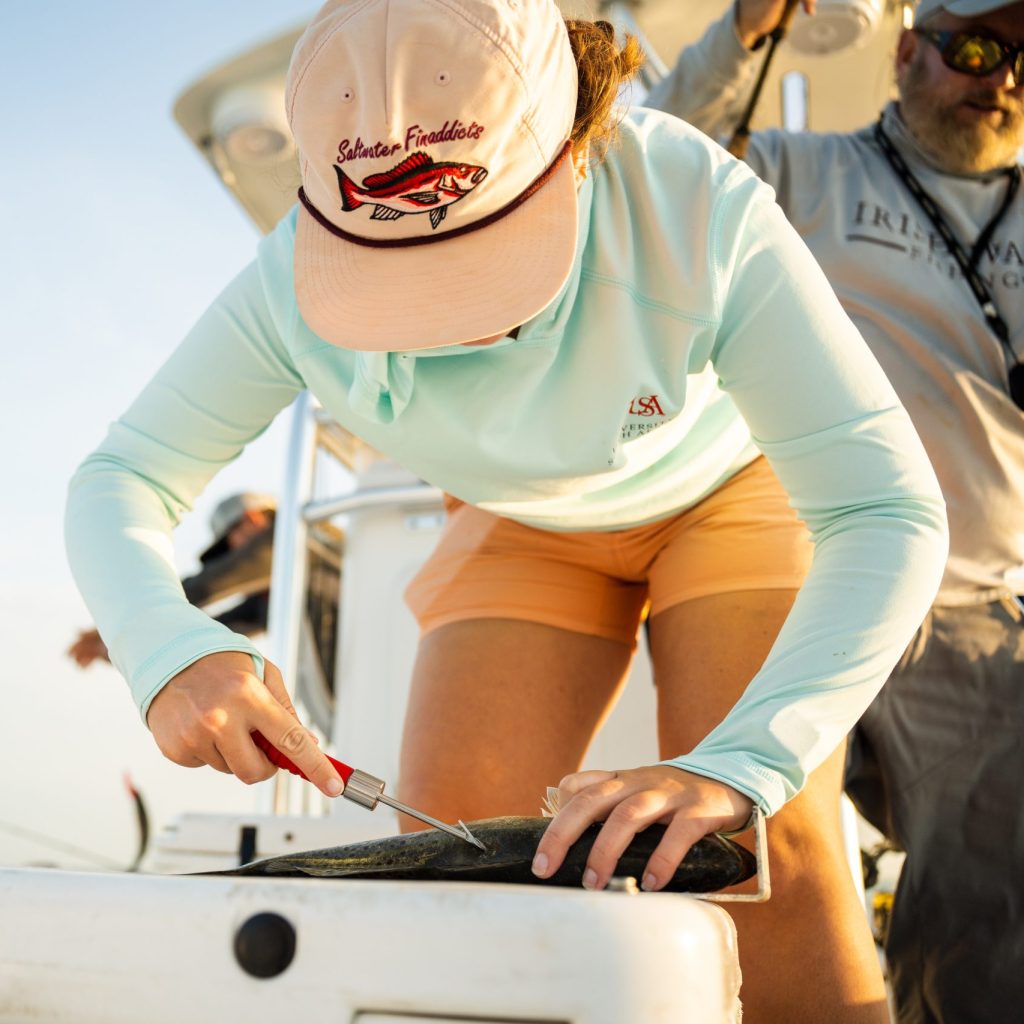Fish tagging is a powerful tool for the study of fish in coastal fisheries management where ever it’s used, allowing fishery scientists and fishery managers to keep tabs on the growth, mobility and to some extent the mortality rate of various fish.
When anglers recapture a tagged fish and report the info, researchers can track the movement of the fish and also see how much it has grown during from the time when it was tagged to get an idea of the general growth rate of that species of fish in that given estuary.
The rate of tag return also gives fishery managers some idea of fishing pressure and angler success—if all the fish that are tagged are re-caught, it’s likely fishing pressure is so high that management measures will be needed, while if only a few are re-caught, assuming good survival rates after tagging, it’s likely the fishery does not need restrictions.
Seasonal migrations can also be tracked—overall, tagging gives fishery managers some important tools to manage fish populations.
Keys To Successful Tagging in the Study of Fish
The process of tagging and the tag itself shouldn’t influence the fish’s behavior or increase its chances of dying from handling or predators, of course. Also, the tag needs to stay put in the fish. Good tags and proper tagging methods avoid these issues for the most part, researchers tell us.
Captain Richard Rutland, a Mobile Bay guide who helped researchers get the current Alabama inshore tagging program supported funded by the Coastal Conservation Association of Alabama (CCA-Alabama) underway, says successful tagging depends on preparation and working quickly to tag and release each fish. (Rutland is consistently the top tagger in the program, it should be noted.)
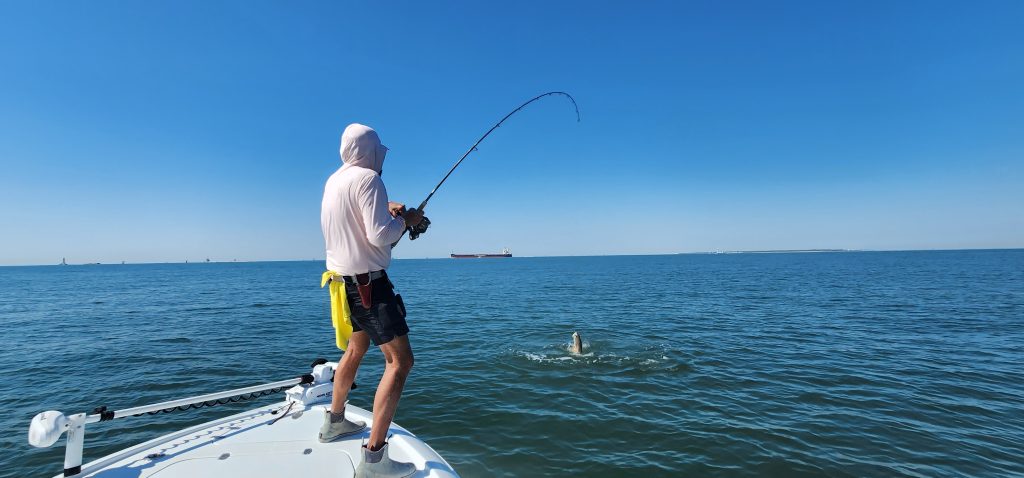
“I’ve got two needles, one for redfish, one for trout. I’ve already got the tags loaded in the needles before we start fishing. The tag numbers are already recorded so all I have to do is pop the fish with a tag, get a measurement on it, and then get it overboard. Then I record the length and the location. It just takes a few seconds on most fish.”
Without this rapid process, more of the tagged fish are likely to die, and this negates a part of the information the study could provide. Rutland notes that seatrout are particularly sensitive to handling, and must be tagged and released quickly.
Types Of Fish Tags
Floy or anchor tags are the type used in most angler-tagging efforts. Small lengths of number-coded nylon tubing are “anchored” to the back of a fish with a T-like end, usually inserted near the dorsal fin. This tag is similar to the type of tag that attaches a price label to a piece of clothing. The advantages of anchor tags are that they can be seen outside the body of a fish, they’re relatively inexpensive, and require only moderate instruction for successful insertion. The tags include a phone number or email address to contact so recaptures can be reported.
PIT tags are similar to tags used by veterinarians to return dogs and cats back home. They are about a half-inch long and must be read with a magnetic reader. PIT tags must be placed in the fish by a trained biologist, so are not suitable for use by weekend anglers.
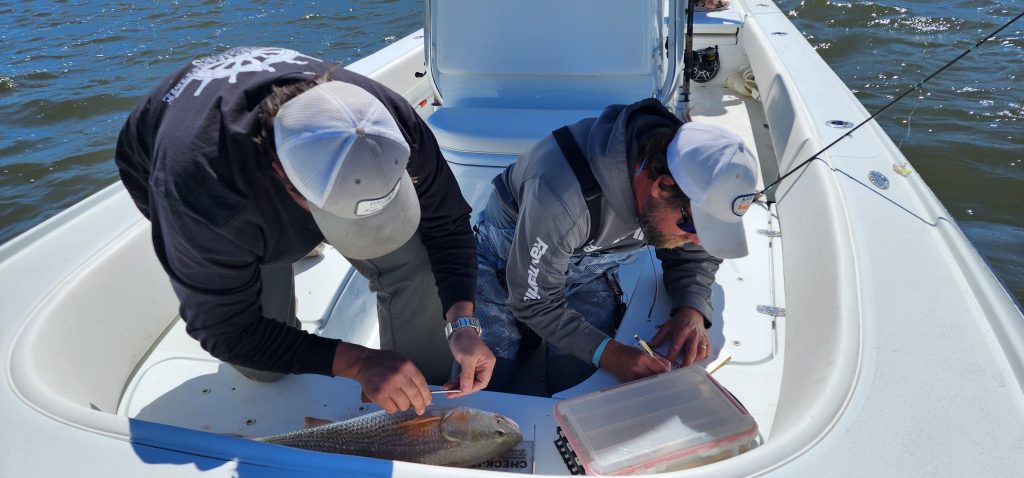
Acoustic or sonic transmitter tags are the most complex and most useful tags, allowing tracking of tagged fish. They allow researchers to map migrations and seasonal movements of fish. But, the transmitters are relatively large and must be placed inside the body cavity of the fish via minor surgery by a trained biologist, so they’re not suitable for use by volunteer anglers. They’re also very expensive compared to anchor tags.
Fish Tagging Programs
Anglers are doing their part in the Southeast to assist in tagging research. TAG Louisiana, for example, is a joint program between the Recreational Fisheries Research Institute and the Coastal Conservation Association of Louisiana. Since its inception in 1985, program volunteers have tagged more than 300,000 fish, and reported more than 15,000 recaptures.
The University of Southern Mississippi also sponsors a fish tagging program for Mississippi anglers—see details here: https://www.usm.edu/fisheries-research-development/tag-release-program.php. Georgia’s DNR also hosts a program– https://coastalgadnr.org/Fishtag , and Florida keeps tabs on their snook population via an angler tagging program: https://myfwc.com/research/saltwater/fishtags/snook.
Alabama now has a vigorous inshore tagging program thanks in large part to input from volunteer anglers and the Coastal Conservation Association-Alabama working in concert with the Fisheries Ecology Lab at the University of South Alabama and Dauphin Island Sea Lab.
Tag Alabama gives anglers the opportunity to participate in collecting data and research on spotted seatrout, red drum, Atlantic tripletail and Atlantic tarpon in coastal Alabama by doing what they love most; fishing.
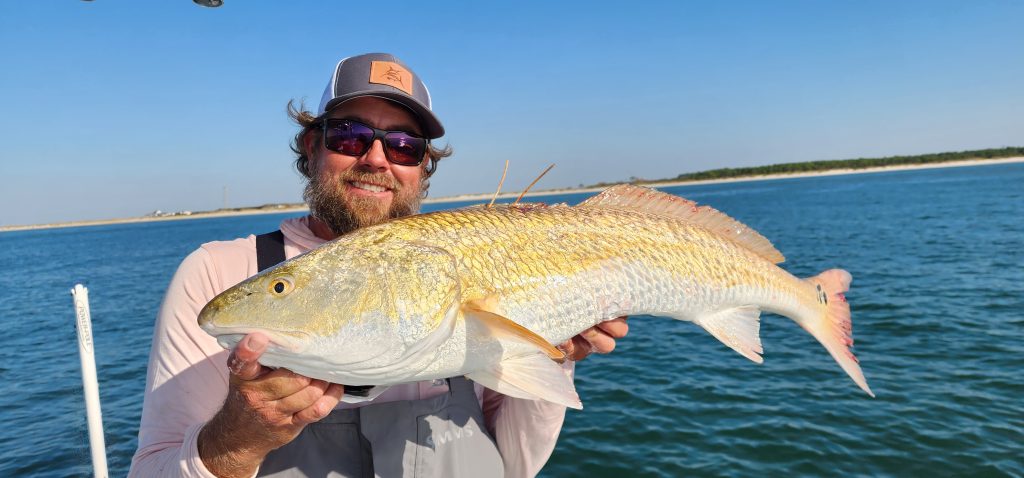
Each tagger attends a training workshop where they receive a tagging kit, instructions on handling and tagging, and support for data entry in a web logging system. Since 2018, Tag Alabama has grown to include 1100 participating anglers (over 900 recapture anglers,193 taggers) resulting in over 10,017 fishes tagged and 1,385 recaptures reported.
“There’s no way we could get this kind of data with paid researchers catching and tagging fish,” says Dr. Sean Powers, director of the School of Marine and Environmental Sciences at the University of South Alabama. “The CCA funding has been a huge help, but even more so the volunteer taggers are fish-reporting anglers have made it a success because so many participate.”
With the help of anglers, researchers report identifying patterns of movement, particularly in red drum and seatrout, which make up 95% of the fish tagged.
Red drum recapture rates (18%) and days at liberty (152 ± 182 days) were higher than seatrout (9% recapture rate; 84 ± 94 days at liberty).
Distance traveled from the initial capture location was similar between both red drum (17 ± 28 km) and seatrout (14 ± 17 km) with 52% of red drum and 45% of seatrout recaptured within 3 miles of their initial location.
Study of Fish Moving With The Seasons
Broad-scale seasonal movement patterns were also apparent between cooling (September – February) and warming (March – August) seasons for these species. As most coastal Alabama anglers know, the majority of trout and reds head for the back country, dredge holes and rivers in cold weather, moving back to the flats and bays in warm weather.
Richard Rutland reports that, while the fish make large movements seasonally, some hardly move at all from day-to-day.
“I once tagged a trout by Dauphin Island Bridge, recaptured it two years later a quarter mile away and it had only grown from 20” to 21” Rutland recalls. “I caught one 16” trout three times in four days within 100 yards of the same spot, but that’s unusual, trout usually do move quite a bit day to day.”
He says reds are often more homebodies.
“I’ve recaptured a lot of reds, sometimes in the same spot, literally on the same docks. It might be six months later—he’s still there. But sometimes they take off and go 50 miles, too.”
Knowing whether the fish stay or go would be impossible without the tagging program.
The Tag Alabama Program
This program receives much of its funding from the sales of CCA specialty vehicle license tags, and when a driver buys a CCA tag, their fees go a long way to support this vital program.
Anglers who are members of CCA are automatically eligible to take part in the Tag Alabama program, and there’s an in person training session-in person tagging orientation/seminars either in person or online- to demonstrate how fish can be safely tagged, how to keep and maintain data from the fish, and how to submit data to the researchers so it can be entered into the program’s data base. There are annual contests for anglers who have tagged the most fish and categories and rewards for professional guides and for non- professional anglers.
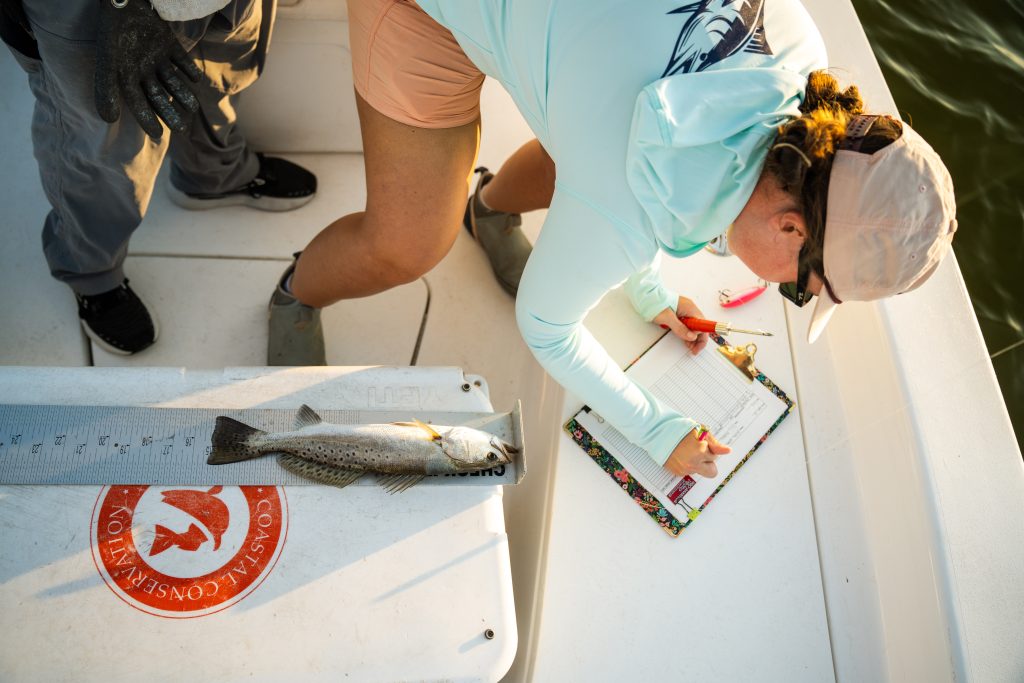
CCA covers the cost of the tagging kits, tags, tag needles, seminars, recaptured fish reward fulfillment, sending out the hats or shirts for angler who catch and report a tagged fish.
“The two requirements for taking part in the Tag AL program are simple,” says Blakeley Ellis, executive director of CCA-Alabama. “You must be an active member of CCA and the angler must attend a tagging seminar either in person or online.”
Interested anglers can contact CCA-Alabama at info@ccaalabama.org or call the CCA State Office 251-478-3474.
Win Stuff By Reporting Tags
All tags are reported through a web portal tags.southal.edu. Anglers reporting fish receive a Tag Alabama hat or t-shirt. In September and October 2023, 300 high dollar reward tags were also released. These bright yellow tags (as opposed to the traditional green and orange tags) entitle fishermen to a $250 value gift card in addition to the signature hat or t-shirt. Anglers also get a personalized report of where their recaptured fish was originally tagged. The high-reward tags are good until Oct. 1, 2025.
High dollar reward tag (yellow)–Limited time to claim $250 reward (before 10/1/2025). Please clip tag and follow directions at reporting web site.
Regular Tag Alabama tag (orange or green) require the angler to record the tag number, length of fish and the date it was tagged. You can keep or release as you would normally do with your fish. Follow directions at reporting web site to claim your t-shirt or hat.
If it’s a redfish or seatrout with a yellow $250 value tag you need to clip the tag and send it to address below to receive reward:
Dauphin Island Sea Lab
Attn: Crystal Hightower
101 Bienville Blvd
Dauphin Island, AL 36528
Bottom line is anglers can score some rewards for themselves at the same time they’re helping the future of their fishery by participating in the Tag Alabama program.

